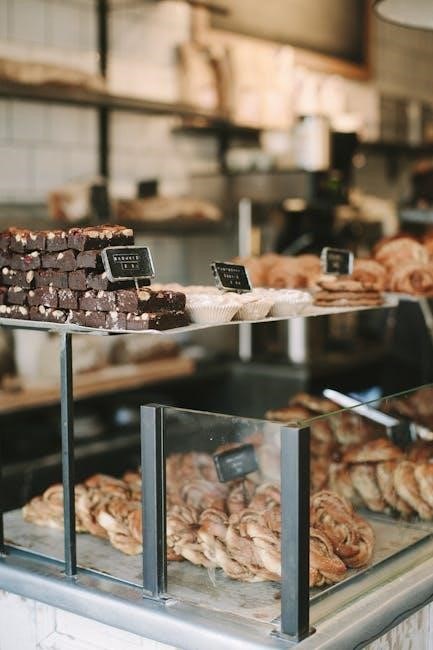Welcome to the world of cookie baking! Discover the basics of creating delicious treats, from essential ingredients to perfecting oven temperature and baking time.
1.1 Understanding the Basics of Cookie Dough
Cookie dough is the foundation of baking delicious cookies. It typically consists of butter, sugar, eggs, and flour, with additional ingredients like vanilla or mix-ins. Creaming butter and sugar creates a light texture, while eggs bind ingredients. Overmixing can lead to tough cookies, so mix until just combined. Chilling dough helps flavors meld and ensures better texture. Proper dough preparation is key to achieving soft, chewy, or crispy results.
1.2 Importance of Oven Temperature and Baking Time
Oven temperature and baking time are critical for perfect cookies. Preheat to 325-375°F, adjusting based on oven specifics. Bake for 8-16 minutes, depending on desired texture. Golden edges indicate doneness; Overbaking leads to dryness, while underbaking may result in soft centers. Monitor cookies closely, especially in the final minutes, to achieve the ideal texture—chewy, soft, or crispy.

Essential Ingredients and Tools
Key ingredients include butter, sugar, flour, and vanilla for flavor. Tools like parchment paper, cookie scoops, and baking sheets ensure perfect texture and baking consistency.
2.1 Key Ingredients for Perfect Cookie Texture
Butter and sugar are foundational for tenderness and sweetness. Flour provides structure, while baking soda or powder aids rise. Eggs bind ingredients, and vanilla enhances flavor. Using a mix of white and brown sugar ensures chewiness, while cornstarch helps retain softness. Quality ingredients like real butter and pure vanilla extract elevate texture and taste, making each cookie deliciously consistent.
2;2 Must-Have Tools for Baking Cookies
A cookie scoop ensures uniform portion sizes, while parchment paper prevents sticking. A baking sheet is essential for even cooking, and an oven thermometer guarantees accurate temperature. A mixer or whisk creams butter and sugar, and a rubber spatula folds ingredients gently. A wire rack cools cookies perfectly, and a rolling pin helps with dough handling. These tools streamline the baking process for professional-like results.

Preparing the Oven and Baking Sheets
Preheat your oven to the specified temperature and line baking sheets with parchment paper for non-stick baking and easy cleanup during cookie preparation.
3.1 Preheating the Oven to the Right Temperature
Preheating your oven to the correct temperature is crucial for even baking. Set your oven between 325°F and 350°F, depending on the recipe and oven type. Ensure accuracy with an oven thermometer. Preheating ensures cookies bake evenly, preventing undercooked or burnt edges. Most recipes require 10-14 minutes of baking time, but this varies based on cookie size and desired texture.
3.2 Lining Baking Sheets with Parchment Paper
Lining baking sheets with parchment paper is essential for easy cookie removal and cleanup. It prevents cookies from sticking and promotes even baking. Place a sheet of parchment paper on the baking tray before adding dough. This step ensures cookies retain their shape and bake uniformly. For extra non-stick protection, lightly spray the paper with cooking spray if desired. Parchment paper also simplifies post-baking cleanup, making it a must-have for cookie baking.

Dough Preparation and Portioning
Prepare dough by creaming butter and sugar, then mixing in eggs and dry ingredients. Use an ice cream scoop to portion dough evenly for consistent cookie sizes.
4.1 Mixing and Creaming Techniques
Creaming butter and sugars until light and fluffy ensures a tender texture. Beat for 2-3 minutes using an electric mixer until pale and airy. Gradually add eggs and vanilla, mixing well. Combine dry ingredients separately, then fold into the wet mixture until just combined. Avoid overmixing to prevent tough cookies. For chewier results, mix in melted butter and extra egg yolk. Chill dough if time allows for better flavor development.
4.2 Scooping Dough for Consistent Cookie Sizes
Use a cookie scoop or ice cream scoop to portion dough evenly, ensuring uniform baking. Leave 2 inches between each cookie on parchment-lined sheets. This promotes even spreading and prevents cookies from merging. For precise control, chill dough briefly to firm it up. Consistent sizing ensures identical bake times, avoiding undercooked or overcooked areas. This step is crucial for achieving professional-looking results with every batch.

Baking Process
Preheat the oven to 325-350°F, place dough on parchment-lined sheets, and bake for 10-14 minutes. Cookies are done when edges are golden brown; cool briefly on sheets.
5.1 Understanding the Role of Oven Temperature
The oven temperature plays a crucial role in cookie baking, as it affects texture and appearance. The ideal range is 325°F to 350°F, depending on oven type and size. Preheating ensures even baking, while incorrect temperatures can lead to undercooked or overcooked cookies. Placing sheets on the middle rack prevents burning and promotes consistency. Monitor closely, as variations in temperature can significantly impact the final result.
5.2 Monitoring Baking Time for Desired Results
Baking time is critical for achieving the perfect texture. Cookies typically bake for 8 to 14 minutes, depending on size and oven temperature. For soft, chewy cookies, bake until edges are lightly golden. For crisp cookies, extend baking time slightly. Avoid overbaking, as this can lead to dryness. Check cookies midway to ensure even cooking and rotate the sheet if necessary. Proper timing ensures cookies are baked to your desired texture, whether soft or crispy.

Cooling and Storage
Cool cookies on the baking sheet for a few minutes to set before transferring to a wire rack; Proper cooling helps maintain texture and prevents sogginess.
Store cookies in an airtight container to retain freshness. For longer storage, freeze cookies or dough, ensuring they remain fresh for future baking enjoyment.
6.1 Cooling Cookies on Baking Sheets
Cool cookies on the baking sheet for 5-10 minutes after baking to set their shape and texture. This step prevents them from breaking when transferred. Use a wire rack to finish cooling, ensuring crispness and avoiding sogginess. Letting cookies cool slightly before moving them helps maintain their structure and prevents breakage.
6.2 Storing Cookies to Maintain Freshness
To keep cookies fresh, store them in airtight containers at room temperature. Separate soft and crispy cookies with parchment paper to maintain texture. For longer freshness, freeze cookies in sealed containers or ziplock bags. Label and date them for easy tracking. Frozen cookies can be enjoyed for up to 3 months. Proper storage ensures cookies stay flavorful and retain their desired texture for a longer period.

Tips for Achieving the Perfect Texture
For soft, chewy cookies, use melted butter and extra brown sugar. Add cornstarch for chewiness. Crispy edges require longer baking. Adjust ingredients and baking time for desired texture.
7.1 Secrets to Soft and Chewy Cookies
For soft, chewy cookies, use melted butter and extra brown sugar to retain moisture. Add cornstarch to inhibit gluten development, ensuring tenderness. An extra egg yolk enhances richness and chewiness. Bake at a lower temperature (325-350°F) for 10-14 minutes. Avoid overbaking; edges should be lightly golden. Chilling dough beforehand helps preserve moisture and texture, resulting in perfectly soft and chewy cookies every time.
7.2 Techniques for Crispy Cookie Edges
For crispy cookie edges, bake at a higher temperature (350-375°F) for 12-16 minutes. Use white sugar instead of brown sugar to promote caramelization. Avoid overmixing dough to prevent toughness. Bake until edges are golden brown, then cool on the sheet for 5 minutes to set. Properly preheating the oven ensures even cooking, while slightly overbaking yields crunchy edges without compromising flavor. This method guarantees a satisfying crunch in every bite.

Common Mistakes to Avoid
Overmixing dough leads to tough cookies, while incorrect oven temperature affects texture and baking time, causing undercooked or burnt results. Avoid these errors for perfect cookies.
8.1 Overmixing the Dough
Overmixing the dough develops excess gluten, making cookies tough and dense. Mix wet and dry ingredients separately, then combine until just incorporated. Stop once a cohesive dough forms to ensure tender, chewy cookies. Avoid overworking to maintain the desired texture and prevent cookies from becoming hard or unpleasantly firm after baking.
8.2 Incorrect Oven Temperature Settings
Incorrect oven temperature can ruin cookie texture and appearance. If the oven is too hot, cookies may burn on the edges before cooking through. If too cold, they may spread unevenly or remain undercooked. Always use an oven thermometer to ensure accuracy. Deviating from the recipe’s recommended temperature can lead to disappointing results, so precise temperature control is essential for perfect cookies.

Advanced Techniques and Variations
Elevate your cookie game with unique mix-ins, freezing dough, and creative baking methods. Explore advanced techniques to diversify flavors and textures for exceptional results.
9.1 Adding Unique Mix-Ins for Flavor
Enhance your cookies by incorporating unique mix-ins like crushed nuts, dried fruits, or candy pieces. These additions create texture and flavor contrasts, making each bite exciting and personalized.
9.2 Freezing Dough for Future Baking
Freezing cookie dough is a convenient way to preserve it for future use. Scoop and freeze individual portions on a parchment-lined sheet until firm, then transfer to a freezer bag. Bake frozen dough at 350°F for 12-14 minutes, adding a few extra minutes if needed. This method ensures fresh, homemade cookies anytime without the hassle of preparing dough from scratch each time.



